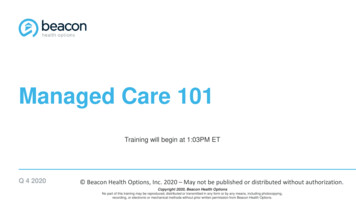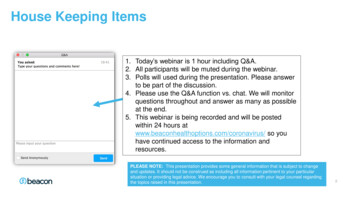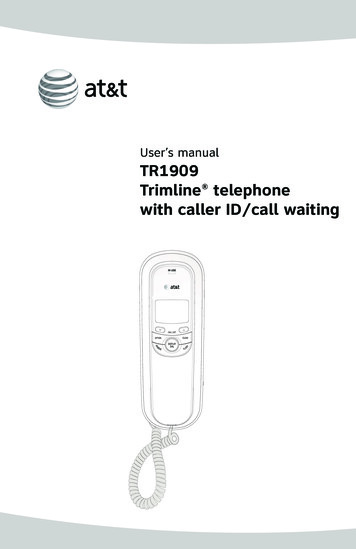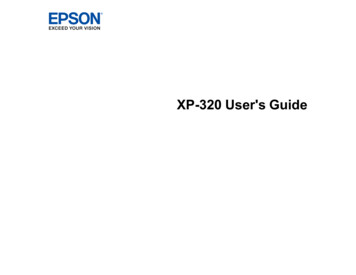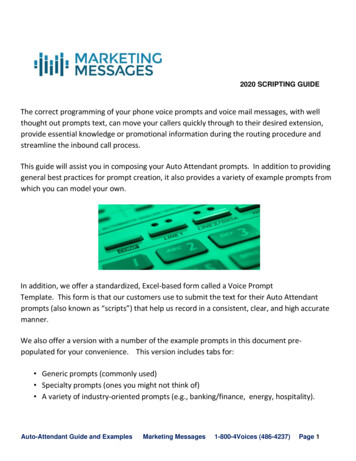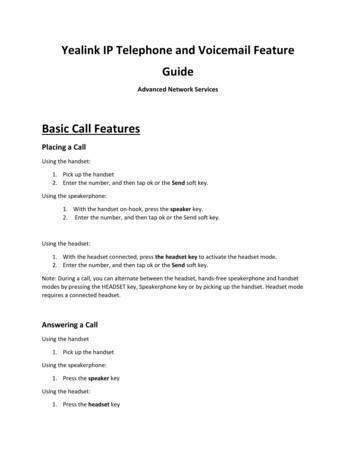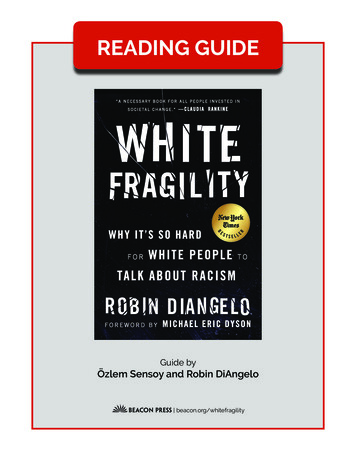
Transcription
READING GUIDEGuide byÖzlem Sensoy and Robin DiAngeloBeacon Press beacon.org/whitefragility
BEFORE YOU BEGIN:SUGGESTIONS FOR DISCUSSIONThis reading guide is intended to support formal and informal discussions of White Fragility. We offerthe following pedagogical tips as you organize your discussion.On SizeSmall group discussions work best when the size of the group is large enough to advance discussion, butnot so large that any member of the group can avoid sharing—or conversely, wants to share, but cannotfind airtime to do so. For this reason, it is recommended that groups target a size of five to seven members. If you are part of a larger study group, just organize yourselves into smaller sub groups of approximately five people.On CompositionThere can be strategic advantages to organizing yourself into what are sometimes called affinity groups,wherein people with a shared identity (such as cis-men, or Asian women, or Indigenous people) workthrough issues particular to them, in a closed group. If your group is diverse, discuss how you want toorganize yourselves (in a mixed group or an affinity group for all or part of various chapter discussions).On Monitoring the GroupIf you are self-monitoring your group, discuss how you will assign a facilitator for each session. Thiscan be a rotating responsibility if you plan to meet over multiple sessions. The task of the facilitator willinclude keeping the discussion on topic, ensuring shared airtime, and note-taking (if part of a formaldiscussion group), as well as ensuring that the group’s time is monitored.On FacilitatingTips for facilitators of white discussion groupsBased on the following patterns, it is highly recommended that a facilitator or team of facilitators beassigned when primarily white groups discuss racism. Facilitators should think of themselves as guidesrather than as teachers. This means the overall task of the facilitator is to keep the group focused and ontrack, with equitable sharing of the airtime. This will be easier to do if at the start of the discussion youtell the group that this is your task. You could even name the patterns ahead of time and ask group members to watch out for these themselves.Common Patterns1. Distancing: Identifiable via expressions including “People should just ,” “Society is ,” “Howdo I tell my coworker ,” “What about all the people who aren’t here today who should be ,”“The executive team at my workplace ,” and “My family member .”Response techniques: “Can you speak to how you see this in your own behaviors/thoughts/beliefs in life/work?” “What part do you see yourself playing?” “What might you do ?”“How is the most effective way for someone to talk with you about your racism?”Find it online at beacon.org/whitefragilityWhite Fragility Reading Guide1
2. Checking out: Identifiable via behaviors including texting, working on laptop, engaging in sideconversations.Response techniques: At the start, ask participants to put phones/laptops away. Explain thateffective discussion on racism often causes disequilibrium for those of us who are white andthat technology functions as a way to check out. Further, when people of color are present,the distraction of technology sends a problematic message. Someone who has an emergencyor is expecting a text or call should leave the room at that time. Regarding side conversations, the facilitator might say, “I am having trouble hearing. Please give your attention to thespeaker.”3. Dominating the discussion: The same person or people speaking first, at length, immediately,and/or several times while others sit back in silence.Response techniques: “Who haven’t we heard from?” “Let’s wait a little longer to makespace for people who need more time.” “I’m going to ask that if we have spoken twice already, we wait until everyone else has had a chance before we speak again.” “Let’s go aroundthe table and check in.” “Does anyone else want to share their perspective?” “We all have aresponsibility to share our thoughts so others in the group know where we’re coming from orwhat we’re struggling with.”4. Positioning themselves as already getting this/Giving evidence for why this discussion doesn’tapply to them: “I already know all this.” “I come from and I can’t believe how white it ishere.” “I realized many years ago that .” “I am married to/have children who are ,” followedby distancing (rather than insight and recognition that this doesn’t exempt them and their learning is not finished).Response techniques: “The book poses an important question, ‘How do we know howwell we are doing?’ “Where do you see your current learning edge?” “DiAngelo states thatnothing exempts us from the forces of racism. How are situations that are unique to us stillinformed by racism?” “How does being white shape one’s sense that they are ‘beyond’ thisdiscussion?” “Can you name three actions in the last month that demonstrate your awarenessin practice?”5. Hopelessness: “Racism is never going to end.” “I can’t do anything.” “What are we supposed todo?” “This is just about making us feel guilty.” “We have been doing this for years now and nothing changes.” “The administration are the ones that need this and they just don’t care.”Response techniques: “The author speaks to the question of guilt. What points does shemake?” “If we apply the question the author asks, How does our discouragement function? howwould we answer?” “What concrete actions have you attempted thus far? What books haveyou read? What antiracism networks have you joined? The perception that nothing can bedone often keeps the existing system in place.”6. Expecting people of color to teach us (white people) about race: Turning to people of colorfor answers or to go first: “I grew up in a sheltered environment, so I don’t know anything aboutrace.” “Sharon, tell me about the racism you have experienced.” “Sharon, you go first.”Response techniques: If you are in a multiracial reading group, don’t assume that the people of color will speak first. If uncertain, ask them what they prefer. “While those of us who2White Fragility Reading GuideFind it online at beacon.org/whitefragility
are white need to listen to people of color, in this context let’s take some risks and go first.”“People of color and Indigenous people have spent a lot of time thinking and speaking outabout white supremacy and against racism. This is the time for white people to step up tothe conversation.” “Mainstream society often has us focus on the targets of oppression ratherthan the agents. In this setting, focusing on people of color can let white people off the hookfor naming their participation in racist systems.” “How have you managed thus far not toknow the answers to your questions on racism?”7. Claiming this discussion doesn’t apply to them because they are not from the US: “I’m fromGermany and we don’t have these issues there.” “Canada is a multicultural society.” “It’s completely different where I am from because everyone is the same.”Response techniques: “At what age were you aware that black people existed? Where didthey live? If in Africa, what were your impressions of Africa? Where did you get your information about Africa?” “Did you watch Hollywood movies? If so, what impressions did youget about African Americans from US movies? What about Disney movies and cartoons?”“What was your relationship to Asian heritage people? What were Asian people like, in yourmind?” and so on.Countering Common Patterns via Silence BreakersThese sentence starters, termed “silence breakers,”1 are suggested openings intended to address twocommon challenges for white people in cross-racial discussions: First, the fear of losing face, making amistake, or not being able to manage impressions that often prevent white people from authentic engagement. Second, the lack of humility we often have when discussing racism. The silence breakers canhelp engender a stance of curiosity and humility that counters the certitude many white people haveregarding our racial perspectives. In doing so, they tend to open, rather than close, discussion and connection.Silence Breakers1. I’m really nervous/scared/uncomfortable saying this and/but 2. From my experience/perspective as [identity] 3. I’m afraid I may offend someone, and please let know if I do, but 4. I’m not sure if this will make any sense, and/but 5. I just felt something shift in the room. I’m wondering if anyone else did.6. It seems as though some people may have had a reaction to that. Can you help me understand why?7. Can you help me understand whether what I’m thinking right now might be problematic?8. This is what I understand you to be saying: Is that accurate?9. I’m having a “yeah but.” Can you help me work through it?10. I’m engaged but just needing time to process this. What I am working on processing is .21 Adapted from Anika Nailah and Robin DiAngelo2 Excerpted from Robin DiAngelo and Ozlem Sensoy, “Calling In: Strategies for Cultivating Humility and Critical Thinking in Antiracism Education,”Understanding & Dismantling Privilege 4, no. 2, (2014), http://www.wpcjournal.com/article/view/12101Find it online at beacon.org/whitefragilityWhite Fragility Reading Guide3
Additional Tips for a Productive DiscussionAs DiAngelo notes, white people addressing white fragility surfaces several dilemmas. First, it requiresthat white people be centered in the conversation about racism. This can be problematic because itreinforces the white centering that is taken for granted in society at large (it is the author’s hope, however, that it is a centering that exposes, rather than protects, the workings of white supremacy). Second,it positions white people—yet again—as the experts. Based on these dilemmas, the following points areimportant to keep in mind:1. This book and its arguments build on antiracism scholarship and activism that people of colorhave written for generations. That scholarship has been fundamental to the ability of the authorto explicate white fragility. Use this text as the starting point—rather than the ending point—toeducate yourself on racism. There are many suggestions for engaging with the work of people ofcolor in the Resources for Continuing Education section of the book.2. The primary goal for white people working to understand racism is not to learn how racism impacts people of color. The primary goal is to recognize how the system of racism shapes our lives,how we uphold that system, and how we might interrupt it.3. For people of color, multiracial, and Indigenous peoples who are part of an informal or formaldiscussion group, the book and this guide will hopefully validate your lived experiences and offersome helpful insight into the challenges of trying to talk to white people about racism. Like thebook, this guide is primarily focused on raising the consciousness and increasing the cross-racial skills of white people. In so doing, many of the questions will be specific to them. Yet whilethe work of this text is primarily focused on the role that white people play within the systemof racism, people of color are exposed to the same messages and must also consider how thosemessages have impacted them and the resultant role they may play. This dynamic is colloquiallydescribed as “assimilation” (or “acting white”) and is described in scholarship as “collusion.” Theseterms refer to people of color upholding values and behaviors that negatively impact their ownand other groups of color and ultimately support white supremacy. There are many pressures tocollude, the foremost of which is that there are rewards for conformity with the system. If webehave in ways that the dominant group finds favorable, we will likely receive benefits (or at leastminimize penalties) in our daily interactions with them. As you study the dynamic of white fragility, consider your role and responsibilities in relation to collusion and adapt questions accordingly and as needed.Note for those using this guide outside of the US contextThe dynamics of white fragility are familiar in all societies in which white people hold institutionalpower and/or have a white settler colonial history, including Canada, Australia, New Zealand, Europe,and South Africa. While the book focuses on the specific sociopolitical context of the US, it is for youto reflect on how these dynamics manifest in your specific sociopolitical context. For white people whodid not grow up in the US but live in the US now, consider how US-based racial dynamics (and globallycirculating US cultural stories and images) shape your current ideas about race, your life, and cross-racialrelationships.4White Fragility Reading GuideFind it online at beacon.org/whitefragility
For all readersThe chapter questions are intended to deepen your reflection and understanding of the chapters andconstructively inform your response to white fragility.Keep the following principles in mind. You may need to return to them on occasion, so consider postingthem in the room or having them available on cards:1. A strong opinion is not the same as informed knowledge.2. There is a difference between agreement and understanding. When discussing complex social andinstitutional dynamics such as racism, consider whether “I don’t agree” may actually mean “I don’tunderstand.”3. We have a deep interest in denying the forms of oppression that benefit us. We may also havean interest in denying forms of oppression that harm us. For example, people of color can denythe existence of racism and even support its structures. This denial may keep them from feelingoverwhelmed by the daily slights or protect them from the penalties of confronting white peopleon racism. However, regardless of the reason, this denial still benefits whites at the group level,not people of color.4. Racism goes beyond individual intentions to collective group patterns.5. We don’t have to be aware of racism in order for it to exist.6. Our racial position (whether we identify as white, a person of color, or multiracial) will greatlyaffect our ability to see racism. For example, if we swim against the “current” of racial privilege,it’s often easier to recognize, while it’s harder to recognize if we swim with the current.7. Putting our effort into protecting rather than expanding our current worldview prevents ourintellectual and emotional growth.Before you begin discussing chapter by chapter, spend some time reviewing the guidelines above.Chapter 1THE CHALLENGES OF TALKING TOWHITE PEOPLE ABOUT RACISM1. Identify a passage from chapter 1 that invokes any sense of discomfort. Highlight this passageand return to reading it periodically as you work through the book. What does this passage revealabout your socialization into the white racial frame? Does your discomfort shift over time? If so,what supported that shift?2. If you are working through these questions as part of a white discussion group, how will you keepthe discussion on track (focused on ourselves and our own participation)? How will you ensureFind it online at beacon.org/whitefragilityWhite Fragility Reading Guide5
that when common white patterns surface (distancing, intellectualizing, rationalizing), you willwork to identify and challenge them rather than ignore or avoid them?3. How do so many white people feel so confident in their opinions on racism, even as they livetheir lives in segregation?4. How can we make generalizations about what it means to be white when we don’t know eachperson’s individual story?5. What are some constructive ways to use your emotional reactions when your opinions on racismare challenged?6. Explain in your own words the author’s critique of the ideology of individualism.Chapter 2RACISM AND WHITE SUPREMACY1. What does it mean to say that race is “socially constructed”?2. What is the difference between racial prejudice, racial discrimination, and racism?3. What does the author mean when she says that there is no such thing as reverse racism?4. How does the birdcage metaphor illustrate oppression?5. What is scientific racism? Give some examples of how scientific racism is conveyed today.6. What does Cheryl Harris mean when describing whiteness as a form of property?7. What is problematic about the idea of the U.S. as a great “melting pot”? How did the melting potactually work?8. Discuss Coates’s statement that race is the child of racism, not the father.9. The author cites Ruth Frankenberg’s description of whiteness as “a location of structural advantage, a standpoint from which white people look at ourselves, at others, and at society, and a set ofcultural practices that are not named or acknowledged.” Explain each of these dimensions in yourown words.10. How is the author using the term “white supremacy”?The White Racial Frame1. Explain the concept of the white racial frame. What are some examples?2. Take a few minutes to share some of your answers to the reflection questions on pp. 35-37. Whatsurprised you? (These questions can be downloaded as a handout from www.robindiangelo.com.)6White Fragility Reading GuideFind it online at beacon.org/whitefragility
3. What patterns in the answers to the reflection questions do you notice within the group?4. What insights do the answers give you on implicit aspects of our racial socialization?5. What are some ways in which racism is “deeply embedded in the fabric” of society? Provide someexamples.Chapter 3RACISM AFTER THE CIVIL RIGHTS MOVEMENT1. What is the impact of white people not knowing our racial history?2. What is color-blind racism and why is it problematic?3. How did racism change and adapt after the civil rights era? Consider attitudes as well as behaviors.4. Why does the author say that white progressives cause the most daily harm to people of color?5. Why does the author consider young white people today to be no less racist than white people inthe past?6. How would you respond to someone who says, “Doesn’t it all come down to what your parentstaught you?”Chapter 4HOW DOES RACE SHAPE THE LIVESOF WHITE PEOPLE?1. The author traces some of the specific ways that her life has been shaped by racism. Consideryour own socialization. In what specific ways has your life been shaped by racism? (If you arewhite, try to answer this question without mentioning people of color).2. Identify at least three ways that white racial belonging has been conveyed to you in the last week(you might start by opening your wallet and looking at the bills there).3. What are the earliest racial messages you can recall? Try to move beyond what you were openlytold and work to identify implicit messages.4. In what settings have you experienced the expectation of white solidarity/racial silence? How hasthat expectation been communicated to you? How have you responded? What consequences haveyou faced or fear you will face by breaking with white solidarity?Find it online at beacon.org/whitefragilityWhite Fragility Reading Guide7
5. The author describes the power of segregation. She argues that this segregation is “active.” Whatdoes this mean?6. Discuss how various patterns of segregation across your lifespan shape your racial frame.7. If you are white, which of the patterns discussed in this chapter have you seen in yourself ? Whichof the patterns challenge you the most? Why?8. Consider some aspects of your identity other than race (i.e., gender, sexuality, religion, class,ability, nationality, age). How does race shape how you experience these identities? For example, how might being white shape how you experience disability? Poverty? Gender identity andexpression?9. If you are a person of color, how have you witnessed white people enacting white solidarity?10. The author states that white ignorance is not simply a matter of not knowing; it is a highly effective response that protects white investments in racism and thus is actively maintained. Discussthis statement.11. What does the author mean when she says that white people are not, in fact, racially innocent?How can we know much about race if we have lived separately?Chapter 5THE GOOD/BAD BINARY1. What does it mean to say that racism is “a structure, not an event”?2. The author suggests that one of the most effective barriers to talking about racism with whitepeople is the good/bad binary. How have you seen this binary underlying common white responses to charges of racism? How might you respond when the binary surfaces in discussionsabout racism?3. If you are white, share some examples of the good/bad binary in your own responses to suggestions that you are complicit with racism.4. When the author challenges the idea that we are all unique and therefore cannot be generalizedabout, what thoughts and feelings come up for you? How might these thoughts and feelingsfunction?5. The author lists two types of narratives that are commonly used by white people to deny complicity with racism: color-blind and color-celebrate (p. 77). Which narratives have you used yourself, orstill use? If you could speak back to yourself with the voice of the author, how would you counterthe narrative?8White Fragility Reading GuideFind it online at beacon.org/whitefragility
6. How can a white person still enact racism in a close relationship with a person of color? Doesn’tthe close relationship itself prove that the person is not racist? Explain how and why enactingracism in a close relationship with a person of color is not only possible but inevitable.7. If you are white, when was the last time someone challenged you to look at an aspect of yourselfrelated to racism? How did you feel? How did you respond? What insights did/can you gainfrom the exchange? If no one has ever challenged you (or not in a very long time), what mightthat tell you about how whiteness shapes your life?Chapter 6ANTI-BLACKNESS1. The author claims that in the white mind, black people are the ultimate racial other. What doesthis mean?2. What does it mean to say that anti-blackness is present across all communities of color, evenwithin black communities?3. How does the author make the case that the construction of white identity and white superioritywas in fact dependent upon the simultaneous creation of a particular idea of blackness? How arethese ideas sustained?4. What are some of the misunderstandings about affirmative action and what do these misunderstandings reveal about anti-blackness?5. Why haven’t affirmative action programs changed our racial outcomes?6. What does the author mean when she suggests that causing pain and suffering for black peoplerests on a sense of white righteousness?7. Return to the reflection questions on the white racial frame on pp. 34-36 and answer them whilereplacing the term “people of color” with the term “black people.” What do you notice?8. The author states that the film The Blind Side is “insidiously anti-black.” Using the frameworkof the book, explain how a viewer can not notice the anti-black messages yet still be shaped bythem.9. Consider the bulleted list following the author’s analysis of The Blind Side. In which other filmshave you seen these racial scripts?Find it online at beacon.org/whitefragilityWhite Fragility Reading Guide9
Chapter 7RACIAL TRIGGERS FOR WHITE PEOPLE1. Discuss the social taboos mentioned on p. 100. Give examples of each from your own life.2. Explain the triggers listed in this chapter in your own words and share examples of each in dailylife.3. The author writes that white people have limited information about what racism is and how itworks, while at the same time they have very strong opinions about racism. Explain how both ofthese can be true at the same time. In your own words, practice stating the difference betweenhaving information about what racism is and having opinions about what racism is.4. The author shares the story of Mr. Roberts and lists the ways that the two teachers in the storydismissed what they did not understand. Discuss this example. How have you seen or participated in these forms of dismissal?5. How does the author challenge the idea that our intentions are “what count”?6. Discuss Bourdieu’s concept of habitus as a way to understand the racial disequilibrium that leadsto white fragility. In what ways is this concept helpful in explaining how racial disequilibriumworks?Chapter 8THE RESULT: WHITE FRAGILITY1. What is the “discourse of self-defense”? Have you ever used it yourself ? If so, thinking about itnow, how did it function in the interaction?2. Share a time that you experienced your own white fragility or witnessed another white person’s.3. What strategies do white people use to reset white racial equilibrium?4. As a white colleague, how would you explain to Karen (p. 107) what is problematic about herresponse? If you are a person of color, what strategies could you use to address Karen’s whitefragility?5. Why are questions such as “What is the right thing to say?” or “What am I supposed to say?” thewrong questions? How might you respond the next time you hear these questions?6. The author claims that white fragility functions as a form of bullying. How so?7. What is meant by the statement that white fragility is “white racial control.” How does whitefragility function as racial control?10White Fragility Reading GuideFind it online at beacon.org/whitefragility
8. The author ends this chapter by sharing an interaction with a man of color who, when asked whatit would be like for white people to be open to feedback, replied, “It would be revolutionary.”She asks white readers to consider the profundity of this man’s reply. What feelings did you havewhen you read that response?9. How might this man’s reply inform how you respond to feedback from people of color, goingforward?Chapter 9WHITE FRAGILITY IN ACTION1. Why are white people more receptive to other white people (rather than people of color) educating them on race? What does this say about the role white people must play in addressingsystemic racism in society broadly and specifically in our homes, with our friends and familymembers, and in our workplaces with our colleagues?2. What are the opportunities and dilemmas of white people educating each other on racism?3. Discuss the claims on pp. 119-120. Have you ever made any of these claims yourself ?4. Now consider the assumptions underlying those claims on p. 121. Which ones have you held? Doyou still hold some of these? If so, how do they function for you and what would it mean to youto shift them (what do you see yourself as having to “give up”)?5. In your group, take turns speaking back to the assumptions your group members shared in question 4. Which speak backs were the most effective for you?6. What is the language of self-defense and why is it problematic?Chapter 10WHITE FRAGILITY AND THE RULES OF ENGAGEMENT1. The author presents a set of eleven “cardinal rules” (pp. 123-24) when giving feedback to whitepeople regarding racist assumptions and patterns. For each rule of engagement, provide an example of the rule in action.2. What assumptions do these rules rest on?3. DiAngelo presents these rules in a language of critique in order to reveal how they function. Ofcourse the “rules” are rarely explicitly expressed this way. Consider what you hear white people sayFind it online at beacon.org/whitefragilityWhite Fragility Reading Guide11
that communicates “do not give me feedback under any circumstances” etc.? Go through each ofthe eleven rules and share how you have heard these rules expressed in practice.4. How would you rewrite these rules from an antiracist framework? (A worksheet for rewriting therules of engagement can be downloaded from robindiangelo.com/resources.)5. In your own words, what is problematic about common guidelines for building trust in discussions about racism (e.g., “don’t judge”)? How do these guidelines function? Who are they for?Whose comfort do they protect?6. The rules of engagement around white fragility have at least three parts: those giving feedback,those receiving feedback, and those witnessing these exchanges. Practice some language for eachby preparing your own “sentence starters” such as the silence breakers above. How might youbegin to give feedback? How might you respond to feedback given to you? What might you sayas you witness an exchange of feedback?Chapter 11WHITE WOMEN’S TEARS1. The author opens this chapter with the story of a woman of color in a multiracial group statingthat she did not want to be subjected to white women’s tears. Why were white women asked notto cry in the group?2. The author argues that emotions are political. How are emotions political?3. There have been social media critiques of “white feminism.” What are some examples of whitefeminism?4. What does it mean to take an “intersectional” approach? Provide some examples.5. Throughout the book the author reinforces the idea that we “bring our histories with us.” Whatdoes this mean and why is it so important?6. White women often assume a shared sisterhood with women of color. What is problematic aboutthis assumption?7. Discuss some of the ways in which white men’s fragility manifests. What is important for whitemen to understand about the impact of each of these behaviors?8. The author writes, “Since many of us have not learned how racism works and our role in it, ourtears may come from shock and distress about what we didn’t know or recognize. For people ofcolor, our tears demonstrate our racial insulation and privilege” (pp. 135-36). Discuss this passageand the ways that white emotional distress and shock (tears, defensiveness, anger, grief ) shapeconversations on racism. What do these dynamics reveal about the sociopolitical function ofemotions?12White Fragility Reading GuideFind it online at beacon.org/whitefragility
9. Consider how emotions function in public space. For instance, how do white people often readthe emotions of women of color, and peoples of color generally? Consider how
discussion group, the book and this guide will hopefully validate your lived experiences and offer some helpful insight into the challenges of trying to talk to white people about racism. Like the book, this guide is primarily focused on raising the consciousness
